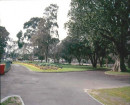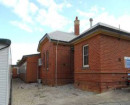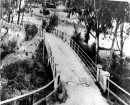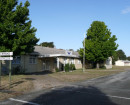MCMILLANS BRIDGE
OVER LITTLE WOADY YALLOCK RIVER, ROKEWOOD-SKIPTON ROAD WERNETH AND ROKEWOOD-SKIPTON ROAD ROKEWOOD, GOLDEN PLAINS SHIRE
-
Add to tour
You must log in to do that.
-
Share
-
Shortlist place
You must log in to do that.
- Download report


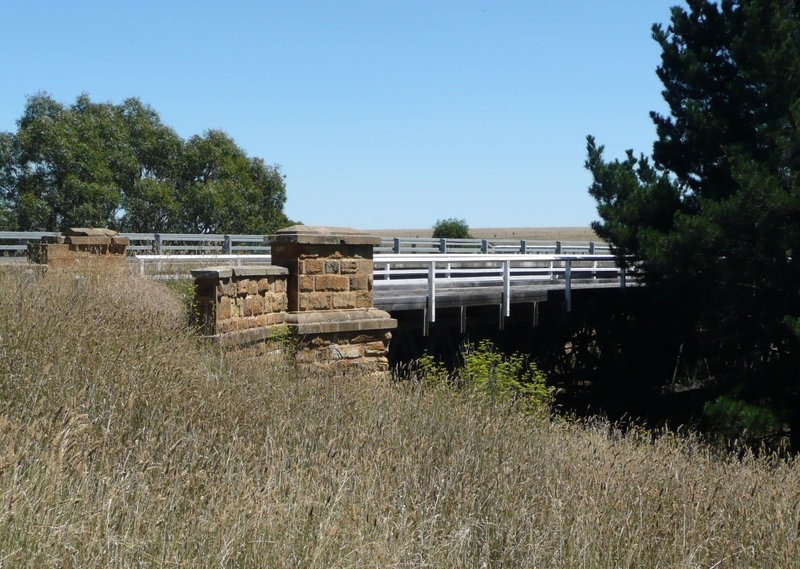
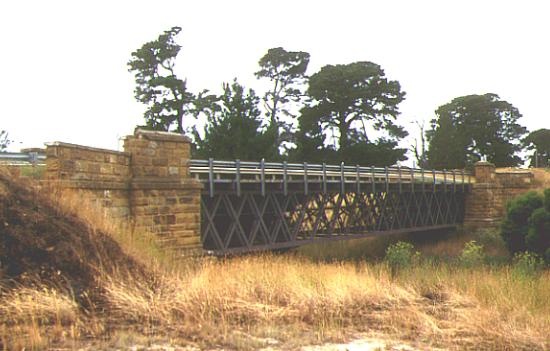

Statement of Significance
McMillans Bridge is situated on the Little Woady Yalloack River crossing of the Rokewood-Skipton Road 6 kilometres west of Rokewood. It was originally built in 1856 by the Central Road Board to the design of Charles Rowland, and incorporates 1888-9 modifications by the Shires of Leigh and Grenville to the design of Charles AC Wilson. It comprises two double-intersection wrought-iron deck-trusses which in 1889 were seated upon 1856 red sandstone abutments (originally constructed for a timber truss superstructure). The longitudinal timber deck is supported by timber cross beams laid across the tops of the iron trusses. The 29 metre single span wrought-iron lattice-girder trusses, connected by iron cross bracing, are of unusually light construction. The original deck width of 6.1 metres has been widened to 7.3 metres. The single-layer longitudinal timber deck is currently unsurfaced. It now has armco rails. The broad road reserve and open grassland terrain allow easy observation of the bridge’s impressive stone-masonry and iron work.
McMillans Bridge is of historical, scientific (technical) and aesthetic significance to Victoria.
It is of historical significance for its 1856 abutments, which are among the very earliest surviving examples of Victorian bridge technology. It is associated with significant engineers: Charles Rowland; Charles AC Wilson, an unusually skilled and adventurous Shire Engineer; and Professor WC Kernot. The early date of the bridge is indicative of the route’s importance in the pastoral pioneering of the Western District, and between Geelong and the Ararat and Streatham goldfields in the 1850s. It is an extremely rare surviving example of a bridge built by Victoria’s short-lived Central Road Board. The 1888-9 wrought-iron superstructure represents another major era in Victoria’s transport history, in which the main responsibility for maintaining Main Road infrastructure fell to the newly instituted rural municipalities which proliferated after 1870. Whereas the original main road bridge had been wholly designed and built by the State road authority, only 25% of the 1888 cost was met by the State. The new superstructure was locally funded, designed, and built. It was built at Geelong by Humble and Nicholson’s important Vulcan Foundry. Its span length and deck width are notable among Victoria’s metal truss and timber deck bridges.
It is of scientific (technical) significance as one of Victoria’s earliest surviving examples of a composite road-bridge, combining an unusual mixture of sandstone masonry abutments, riveted wrought-iron lattice-truss girders, and a longitudinally planked timber deck. The 1856 abutments are very rare examples of superior goldrush masonry bridge abutments (as distinct from integrated masonry arches), constructed according to an old European tradition. Most extant rural examples of such stone masonry abutments for big composite road bridges post-date the freak state-wide floods of 1870, which forced a major reconsideration of rural bridge technology and encouraged more high-level structures. By contrast, the 1888 wrought-iron trusses, of notable span, drew heavily upon the scientific theory and testing facilities of Professor Kernot’s Department of Engineering at the University of Melbourne, and are extremely light, efficient and advanced examples of current bridge technology. The bridge represents an important step in the local evolution of wrought-iron trusses for use in bridge construction: considerable economies were achieved, and iron bridge superstructures became more competitive with traditional hardwood alternatives.
It is of aesthetic significance particularly for the superb red sandstone masonry abutments which support the later neat wrought-iron superstructure elements. The abutments and wing walls feature coursed rusticated stone work, with finely worked string courses and an ornate stepped profile. The design of these substantial masonry abutments is quite distinct from that of other colonial Victorian masonry structures, and possibly reflects the style of Telford, Brunel and early nineteenth-century British engineers who influenced David Lennox and in turn his pupil, Charles Rowland. Although two 1859 sandstone arch bridges survive, sandstone was a far less common bridge-building material in Victoria than the more durable basalt or bluestone.
-
-
MCMILLANS BRIDGE - History
Contextual History:History of Place:
The road across the Little Woady Yalloack Creek at McMillan’s crossing had been established during the pastoral era as the popular original route from Geelong into the Portland Bay (now Western) District, via Shelford, Rokewood and Skipton. The road was also used after the discovery of gold in the district, and in 1852 the route between Geelong and Fiery Creek (Streatham) was officially surveyed. Documentary records from this era indicate that this road was used by traffic between Geelong and the Ararat, Pleasant Creek, and Fiery Creek diggings.
The only known information on the early history of McMillan’s crossing at what was in the 1880s known as McMillan’s Creek or Little Woady Yalloak River (now Mt Misery Creek) on the Upper Western Main Road (now Rokewood-Skipton Road), comes from speeches at the opening of the reconstructed McMillan’s Bridge in 1889. The new iron bridge was the replacement for an old timber truss bridge built by the Central Road Board in 1856, but (not surprisingly) by 1888 ‘quite incapable of any further struggle for existence’. Timber truss bridges of the goldrush era tended to be built of polyglot timbers scrounged from everywhere, and often incorporated imported softwood timbers (eg. Brees Bridge at Keilor on the Mt Alexander Road). The old masonry and timber bridge was officially closed to traffic in mid-March of 1889. The substantial red sandstone bridge abutments of the earlier timber truss bridge were ‘adapted with slight alterations’ for the 1888-9 structure, with the original masonry contractor of 1888 complaining about difficulties caused by their unusual thickness.
The first indication that a new iron-truss bridge was planned for the site came from the Leigh Shire Engineer’s report to a council meeting of 8 February, 1888. Charles A. C. Wilson reported that he had completed ‘plans for the new iron bridge which it was proposed to erect over McMillan’s Creek’, and that it was necessary to expedite their transmission to the Public Works Department for approval. Wilson was instructed to deliver the plans personally. By mid-March departmental approval of Wilson’s bridge plans had been received, and a joint committee of councillors representing Leigh and Grenville Shires agreed to accept the lowest tender for the construction contract, which was that of Humble and Nicholson’s Vulcan Foundry at Geelong. Unsuccessful tenders had emanated from Melbourne and Ballarat. Plans for Wilson’s modified bridge design were exhibited by the Victorian Engineers Association at the Melbourne Centennial Exhibition of 1888.
It took many months to obtain the necessary high grade iron from England, but by late-November of 1888 the contractors were ready to test samples, using Melbourne University’s new testing equipment. The actual construction process was fairly rapid once the old bridge was finally closed in March 1889, and was doubtless expedited by the use of earlier magnificent red sandstone abutments. Although the first mason who contracted to alter the abutments slightly to fit the new iron superstructure experienced some problems, and was sometimes temperamental, this did not seriously impede progress. Wilson was able to inform assembled Leigh councillors on 17 July 1889 that the bridge was already carrying traffic and awaited testing. Grenville Shire was sufficiently impressed to have sent a cheque for £343 as its first instalment towards bridge costs. An official opening was to be arranged, and would take place in conjunction with the official testing of the completed new structure under heavy vehicle loads.
The new wrought-iron and sandstone version of McMillan’s Bridge was officially opened on Friday, 26 July, 1889. The President of Leigh Shire (Cr. John Vernon) was accompanied by the President of Grenville Shire (Cr John Clark), and the opening took place in the presence of various other interested councillors and visitors who marched in procession over the new timber deck after it was declared open by Cr. Vernon. Prior to the official opening the bridge underwent extensive testing of its load-bearing capacity, and came through with flying colours. The usual ‘al fresco luncheon’ followed for the assembled dignitaries, Mrs Stanbrook of the Rokewood Hotel being provider. The new bridge, being on the boundary of Leigh and Grenville Shires, was paid for conjointly by the neighbouring municipalities with the aid of a £400 government grant. Total cost of construction was just under £1,600. The original timber truss and masonry bridge at McMillan’s crossing had cost £3,877 in goldrush times, which indicates the economic importance of being able to re-use those 1856 masonry abutments in 1888-9, as well as the relative importance of the old masonry substructure to the total contemporary bridge structure.
The basic components of the 1888-9 iron and masonry version of McMillan’s Bridge were described in the newspaper report of the bridge’s opening. The ‘very massive’ old red sandstone abutments from 1856 provided a wonderful start. The major superstructure element was composed of two light wrought-iron lattice girders, each 99 feet long, and bridging the stream as a single span. The two main iron trusses were strongly connected by light-weight wrought-iron cross bracing, and this integrated iron work supported a timber deck 20 feet wide. Sawn hardwood cross beams were laid across the tops of the iron trusses in pairs, to support two layers of hardwood planking covered by six inches of fine tarred bluestone metal. It is not stated whether the decking was laid diagonally (as was commonly then the case), although that would have been the obvious engineering logic of the situation. The superstructure was completed by the addition of neat iron handrailings.
In terms of its iron technology this was a very advanced bridge design for its era, and indicates the skill of C. A. C. Wilson as shire engineer, and especially Wilson’s professional interaction with the Engineering Department of the University of Melbourne headed by Professor Kernot. Whereas Sydney University’s engineering department of that era was heavily immersed in making improvements to timber bridge design by utilizing superior Australian eucalypt hardwood materials, Melbourne University’s foundation Professor of Engineering took a special interest in the application of wrought-iron materials to bridge construction.
In the case of McMillan’s Bridge, a large single-span road-bridge superstructure was supported by only 30 tons 11 cwt of imported wrought-iron, incorporated into an unusually light-weight deck-truss design for that era. Such economical and efficient wrought-iron bridge construction depended on the theoretical and scientific-testing input of Professor W. C. Kernot’s university department. In an era when the majority of Victoria’s municipal engineers regarded themselves as ‘practical men’, and suspected too much theory, Wilson was obviously an adventurous municipal engineer prepared to take advantage of the best engineering theory and testing facilities available, and two Western District shires were sufficiently adventurous to follow the lead of Leigh Shire’s engineer. McMillan’s Bridge represents a great advance upon, and a striking contrast to, Wilson’s earlier design of the Shelford iron bridge of 1874.
McMillans Bridge came under the control of the Country Roads Board in 1914, as being part of a designated main road. By 1972 the original iron side-rails had been replaced by timber safety barriers, with a standard C.R.B. diamond-pattern top rail, timber middle rail, timber kerbs and timber posts, presumably to cater for a slight widening of deck. By 1991 these had in turn been replaced by heavy timber posts and a single armco rail from abutment to abutment on each side. More recently, the armco railing has been extended around the abutment parapets and along the road approach on the Rokewood end. The single-layer longitudinal timber deck is currently unsurfaced, in contrast to the original dual-layer timber deck which had a heavy covering of tarred crushed rock.MCMILLANS BRIDGE - Assessment Against Criteria
Criterion A.
The historical importance, association with or relationship to Victoria's history of the place or object.
Its 1856 abutments are among the very earliest surviving examples of Victorian bridge construction. They are essentially intact structurally, and still performing the function for which they were designed.
The early date of the bridge is indicative of the route's importance in the pastoral pioneering of the Western District, and, later, between the port of Geelong and the Ararat and Streatham goldfields.
It is associated with significant Victorian engineers: Charles Rowland of the Central Roads Board, who was a pupil of David Lennox; Charles AC Wilson, an unusually skilled and adventurous Shire Engineer; and Professor WC Kernot.
It is an extremely rare surviving example of a bridge built by Victoria's short-lived Central Road Board.
The 1888-89 wrought-iron superstructure represents another major era in Victoria's transport history, in which the main responsibility for maintaining Main Road infrastructure fell to the newly instituted rural municipalities which proliferated after 1870. Whereas the original main road bridge had been wholly designed and built by the State road authority, only 25% of the 1888 reconstruction cost was met by the State. The new superstructure was locally funded, designed, and built.
The 1888-89 riveted wrought-iron truss was built at the Humble and Nicholson Vulcan Foundry at Geelong, an important engineering works in Victoria's history.
Criterion B.
The importance of a place or object in demonstrating rarity or uniqueness.
The 1856 abutments are very rare examples of superior goldrush masonry bridge abutments (as distinct from integrated masonry arches), constructed according to an old European tradition. Most extant rural examples of such stone masonry abutments for big composite road bridges post-date the freak state-wide floods of 1870, which forced a major reconsideration of rural bridge technology and encouraged more high-level structures.
It is a rare example of a sandstone bridge in Victoria. Although two 1859 sandstone arch bridges survive, sandstone was a far less common bridge-building material in Victoria than the more durable basalt or bluestone.
Criterion C.
The place or object's potential to educate, illustrate or provide further scientific investigation in relation to Victoria's cultural heritage.
The construction features and early date of construction make the bridge's educational potential unusually high. It provides evidence of early road routes, and of early bridge building materials and technologies. Its 1880s superstructure adds to its educational potential regarding nineteenth century developments in bridge building.
Criterion D.
The importance of a place or object in exhibiting the principal characteristics or the representative nature of a place or object as part of a class or type of places or objects.
It is one of Victoria's earliest surviving examples of a composite road-bridge, combining an unusual mixture of sandstone masonry abutments, riveted wrought-iron lattice-truss girders, and a longitudinally planked timber deck.
Criterion E.
The importance of a place or object in exhibiting good design or aesthetic characteristics and/or in exhibiting a richness, diversity or unusual integration of features.
It combination of materials - superb red sandstone masonry abutments, the later neat wrought-iron superstructure elements, and timber decking - is rare and attractive.
Its abutments and wing walls feature coursed rusticated stone work, with finely worked string courses and an ornate stepped profile. The design of its substantial masonry abutments is quite distinct from that of other colonial Victorian masonry structures, and possibly reflects the style of Telford, Brunel and early nineteenth-century British engineers who influenced David Lennox and in turn his pupil, Charles Rowland.
Criterion F.
The importance of a place or object in demonstrating or being associated with scientific or technical innovations or achievements.
In contrast to the heavy masonry abutments, the 1888 wrought-iron trusses, of notable span, drew heavily upon the scientific theory and testing facilities of Professor Kernot's Department of Engineering at the University of Melbourne, and are extremely light, efficient and advanced examples of current bridge technology. The bridge represents an important step in the local evolution of wrought-iron trusses for use in bridge construction: considerable economies were achieved, and iron bridgeMCMILLANS BRIDGE - Permit Exemptions
General Exemptions:General exemptions apply to all places and objects included in the Victorian Heritage Register (VHR). General exemptions have been designed to allow everyday activities, maintenance and changes to your property, which don’t harm its cultural heritage significance, to proceed without the need to obtain approvals under the Heritage Act 2017.Places of worship: In some circumstances, you can alter a place of worship to accommodate religious practices without a permit, but you must notify the Executive Director of Heritage Victoria before you start the works or activities at least 20 business days before the works or activities are to commence.Subdivision/consolidation: Permit exemptions exist for some subdivisions and consolidations. If the subdivision or consolidation is in accordance with a planning permit granted under Part 4 of the Planning and Environment Act 1987 and the application for the planning permit was referred to the Executive Director of Heritage Victoria as a determining referral authority, a permit is not required.Specific exemptions may also apply to your registered place or object. If applicable, these are listed below. Specific exemptions are tailored to the conservation and management needs of an individual registered place or object and set out works and activities that are exempt from the requirements of a permit. Specific exemptions prevail if they conflict with general exemptions. Find out more about heritage permit exemptions here.Specific Exemptions:General Conditions:
1. All exempted plans and alterations are to be carried out in a manner which prevents damage to the fabric of the registered place or object.
2. Should it become apparent during further inspection or the carrying out of alterations that original or previously hidden or inaccessible details of the place or object are revealed which relate to the significance of the place or object, then the exemption covering such alteration shall cease and the Executive Director shall be notified as soon as possible.
3. If there is a conservation policy or plan approved by the Executive Director, all works shall be in accordance with it.
4. Nothing in this declaration prevents the Executive Director from amending or rescinding all or any of the permit exemptions.
5. Nothing in this declaration exempts owners or their agents from the responsibility to seek relevant planning or building permits from the responsible authority where applicable.
Specific Provisions/Exemptions
No permit is required for routine maintenance or minor repairs which replace like with like.MCMILLANS BRIDGE - Permit Exemption Policy
It is the purpose of the permit exemptions to enable routine maintenance and repairs which do not damage the significant fabric of the place, or diminish its cultural significance.
-
-
-
-
-
MCMILLANS BRIDGE
 Victorian Heritage Register H1847
Victorian Heritage Register H1847 -
WESTERN CREEK GRAND JUNCTION CO
 Victorian Heritage Inventory
Victorian Heritage Inventory -
McMillans Bridge
 National Trust H1847
National Trust H1847
-
'Altona' Homestead (Formerly 'Laverton' Homestead) and Logan Reserve
 Hobsons Bay City
Hobsons Bay City
-
-





